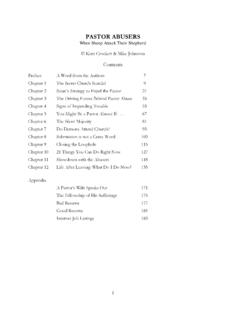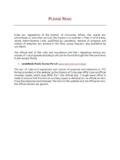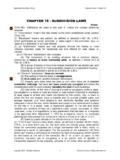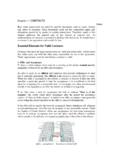Transcription of CHAPTER 11: REFLECTIONS ON THE S P E : G …
1 CHAPTER 11: REFLECTIONS ON THE STANFORD PRISON EXPERIMENT: GENESIS, TRANSFORMATIONS, CONSEQUENCES Philip G. Zimbardo Stanford University Christina Maslach University of California, Berkeley Craig Haney University of California, Santa Cruz PROLOGUE Philip G. Zimbardo In a sense, this CHAPTER does not fit well in the frame of this book on Milgram's paradigmatic research on obedience to authority. It is less about extreme forms of inter personal compliance to the demands of unjust authority than it is about emerging conformity pressures in "total situations" in which the processes of deindividuation and dehumanization are institutionalized. However, in another sense, it is the natural complementary bookend to chapters tied to Milgram's obedience paradigm, which between them hold up the lessons of the power of social situations to overwhelm individual dispositions and even to degrade the quality of human nature.
2 Whereas a central contribution of Milgram's paradigm was to quantify aggression and thus the extent of obedience using a simple but impressive technology, the value of the Stanford Prison Experiment (SPE) resides in demonstrating the evil that good people can be readily induced into doing to other good people within the context of socially approved roles, rules, and norms, a legitimizing ideology, and institutional support that transcends individual agency. In addition, although the obedient participants in Milgram's many replications typically experienced distress for their "shocking" behavior, their participation lasted for only about one half hour, after which they learned that no one was really harmed.
3 By contrast, participants in the SPE endured 6 days and nights of intense, often hostile, interactions that escalated daily in the level of interpersonal aggression of guards against prisoners. Take, as but one example of the confrontations that occurred repeatedly during the prison study, this statement found in a guard's diary: "During the inspection the prisoner grabbed my throat, and although I was really scared, I lashed out with my stick and hit him in the chin." The authority that created the prison setting was typically not in sight of the participants, but rather I, in the role of prison superintendent, became an agency or remote agent overseeing the daily and nightly 2confrontations between these opposing forces.
4 It became my job to hold in check the growing violence and arbitrary displays of power of the guards rather than to be the Milgramesque authority who, in becoming transformed from just to unjust as the learner's "suffering" intensified, demanded ever more extreme reactions from the participants. Indeed, it was just the opposite. This CHAPTER is the product of a 1996 APA symposium held in Toronto, Canada, honoring the 25th anniversary of the SPE. Editor Tom Blass thought that its basic themes could somehow mesh with the other contributions honoring and extending the classic work of Stanley Milgram. That symposium began with my overview of the genesis of the study, outlining some of the processes involved and the lessons learned from it.
5 I highlighted the drama of the study with slides and archival footage, now contained in a video titled Quiet Rage: The Stanford Prison Experiment. Christina Maslach presented the perspective of an "outsider" who witnessed the unimaginable transformations of character of the participants -- and of herself -- and heroically challenged the authority to end the study. Craig Haney, who had assisted in all phases of the study, along with William Curtis Banks, described how current conditions in real prisons could benefit from application of the lessons of the SPE. We follow that same sequential flow here, giving very personal accounts of our experiences in this loosely connected, tripartite structure.
6 But before doing so, I want to exercise the prerogative of seniority to interject some REFLECTIONS on my personal association with Stanley Milgram that links us intimately beyond the facts of our most salient research. So allow me to share a few remembrances of the "good old days" before we turn to our analysis of the Stanford Prison Experiment. My Personal Connection with Stanley Milgram Stanley and I were high school classmates at James Monroe High School in the Bronx, he being considered the smartest kid and I voted the most popular. We sometimes talked about the reasons for seemingly strange or irrational behavior by teachers, peers, or people in the real world that violated our expectations.
7 Not coming from well-to-do homes, we gravitated toward situational explanations and away from dispositional ones to make sense of such anomalies. The rich and powerful want to take personal credit for their success and to blame the faults of the poor on their defects. But we knew better; it was usually the situation that mattered, by our account. After graduation in 1950, we went to separate colleges and graduate schools but were reunited briefly a decade later at Yale University. Stanley had started as a new assistant professor in 1960, whereas I left Yale to start my career at New York University. I returned the next year to teach part time in the School of Education and met with him on a several occasions.
8 Stanley began his landmark obedience studies in 1961, and, when I asked about his research, Stanley chose not to share his ideas or emerging data with me (or anyone else, I gather). He said that he preferred to wait until his work was published, and then he would be pleased to discuss it. But I still regret this lost opportunity to share ideas at their most exciting stage of emergence. 3We exchanged correspondence in 1965; I congratulated Stanley on winning the American Association for the Advancement of Science (AAAS) prize, and he responded with the hope of increasing our contact in the future. He called me a while later to say he was using my book The Cognitive Control of Motivation (Zimbardo, 1969) as a text in his methodology course because it represented the most rigorous and interesting studies testing predictions from dissonance theory.
9 Obviously flattered, I worked at renewing our relationship, planning a jointly authored social psychology textbook along with Bob Abelson (that unfortunately never materialized), calling him more often, and meeting him at conventions. Several interesting conversations deserve mention here. I realized one day while teaching about the Milgram paradigm that we all focus on the obedient participants and ignore the heroic ones who resisted the situational pressures to obey the authority. I wondered what they did after they refused to continue shocking the "learner." Did they get out of their assigned seat and run to aid the victim in apparent distress or insist that the experimenter do so?
10 When I posed this question to Stanley, he searched his memory and answered, "Not one, not ever!" That means that he really demonstrated a more fundamental level of obedience that was total -- 100% of the participants followed the programmed dictates from elementary school authority to stay in your seat until granted permission to leave. We both discussed but did not act on the need for psychologists to study the dissidents, the rebels, the whistle-blowing heroes. Demonstrating the power of the situation to make good people do evil deeds somehow held more appeal to us than the more difficult reverse process of showing how ordinary people could be induced to do heroic deeds within a Milgram-like paradigm.










